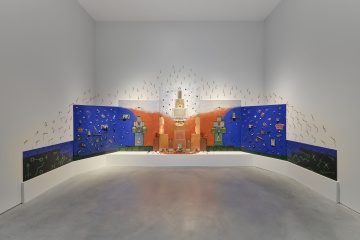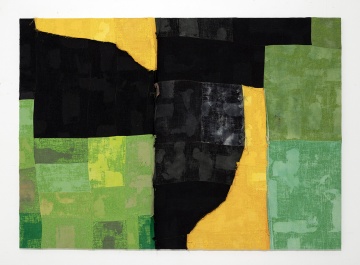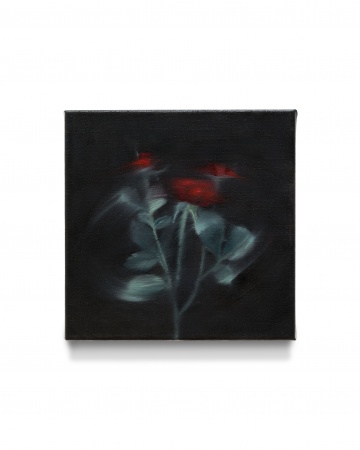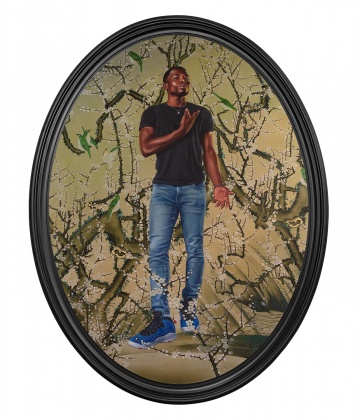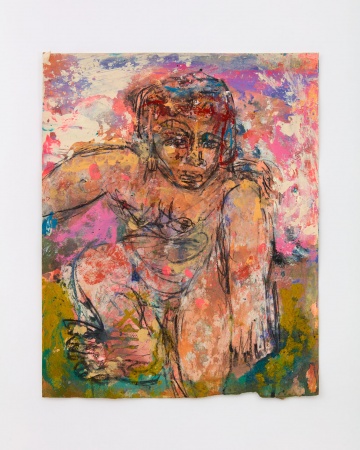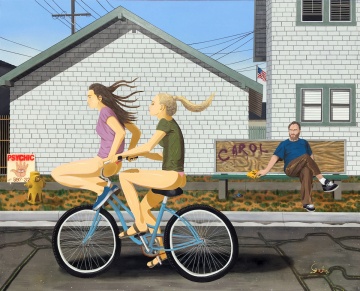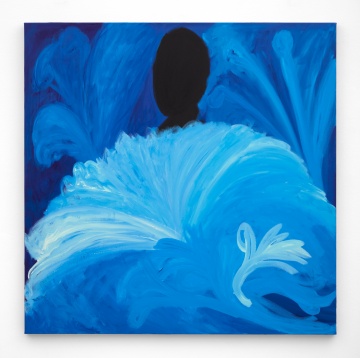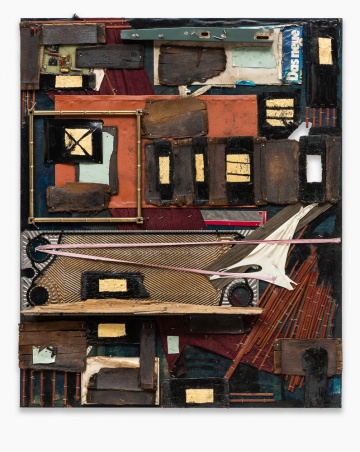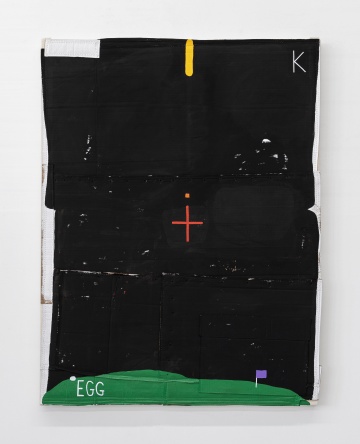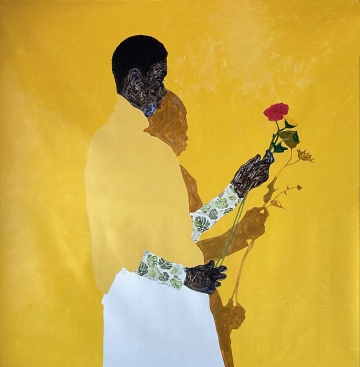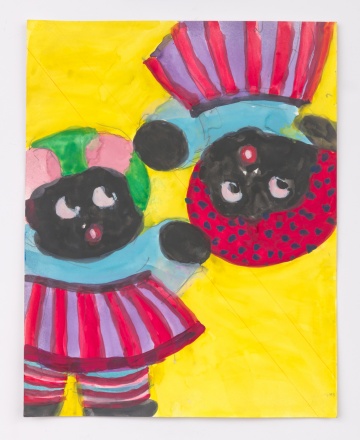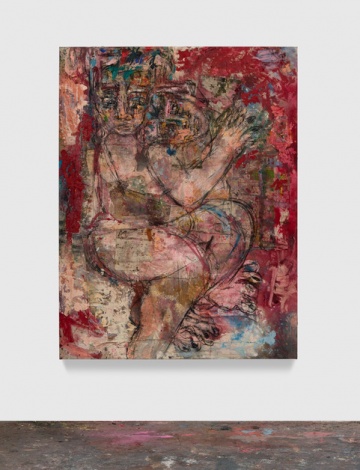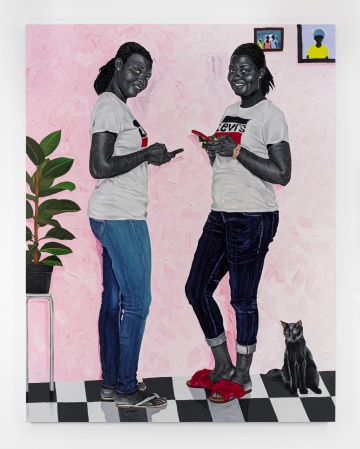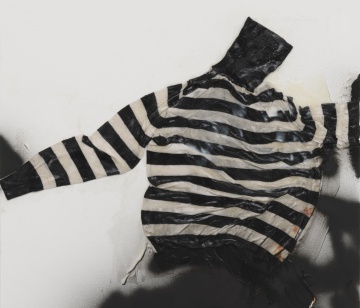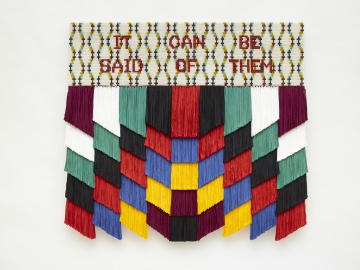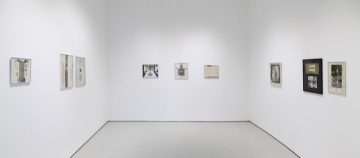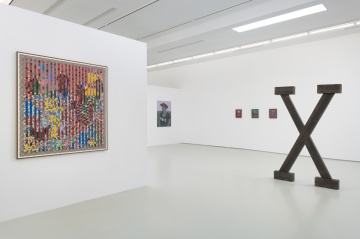Roberts Projects
442 South La Brea Avenue
Los Angeles, CA 90036
323 549 0223
Los Angeles, CA 90036
323 549 0223
Established in 1999, Roberts Projects aims to foster diverse perspectives within a broader context of contemporary artistic practices through its exhibitions and programs, with a focus on artists with challenging, critical voices. The gallery represents multiple generations of internationally recognized, established artists as well as emerging artists. The gallery commissions projects in a variety of media, including painting, sculpture, photography, and film, and programming emphasizing museum-quality, installation-based exhibitions, specifically provocative interventions and expansive surveys of historical significance. The gallery's publication division specializes in exhibition catalogues, contemporary artists' texts, and art historical monographs.
Artists Represented:
Amoako Boafo
Jeffrey Gibson
Eberhard Havekost
James Hayward
Wangari Mathenge
Amoako Boafo
Daniel Crews-Chubb
Lenz GeerkJeffrey Gibson
Eberhard Havekost
James Hayward
Wangari Mathenge
Suchitra Mattai
Mia Middleton
Betye Saar
Evan Nesbit
Collins Obijiaku
Otis Kwame Kye QuaicoeBetye Saar
Ed Templeton
Kehinde Wiley
Brenna Youngblood
Zhao Zhao
Roberts Projects, 2023
Betye Saar
Betye Saar: Mojotech, PST ART: Art & Science Collide
September 14, 2024 - February 28, 2025
Betye Saar: Mojotech
September 14, 2024 – February 28, 2025
Opening Reception Saturday, September 14, 5-7pm
In conjunction with Getty’s PST ART: Art & Science Collide, Roberts Projects is pleased to present Betye Saar’s monumental altar assemblage, Mojotech. Created in 1987 during the artist’s residency at Massachusetts Institute of Technology (MIT), this installation-based work is a testament to the fusion of contemporary technology and the mystique of ancient spirituality.
With Mojotech, Saar speculates on the presence of magic in technology by integrating a variety of ritual objects, charms and symbols with circuit boards and computer parts that draw aesthetic parallels between the natural and modern worlds. As a communal work, visitors are invited to participate by leaving personal or technological offerings at the base of the altar. This process of accumulation is inspired by traditional African sculpture, which incorporates various decorative and “power” elements from across its diverse cultural practices.
Sydney Acosta, Raghvi Bhatia, Molly Bounds, Daniel Crews-Chubb, Anthony Cudahy, Lenz Geerk, Rose Haserodt, Zoe Koke, Becky Kolsrud, Molly Larkey, Audrey Leshay, Kristy Luck, Erica Mahinay, Suchitra Mattai, Chris Oh, AJ Pineda, Otis Kwame Kye Quaicoe, mosie river, Betye Saar, Ian Stanton, Erin Wright and Brenna Youngblood.
On Alchemy
November 16, 2024 - December 21, 2024
Opening Reception Saturday, November 16, 6–8pm
Roberts Projects is pleased to present On Alchemy, a group exhibition that engages alchemy’s rich history and visual
language to re-evaluate artistic production of the 21st century. Bringing together more than 20 individuals working
in painting, sculpture and mixed-media, this exhibition positions artists as the alchemists of our era to generate new
perspectives on contemporary art and meaningful insight into the creative process.
Luke Agada
Luke Agada: Between Two Suns
September 28, 2024 - November 2, 2024
Luke Agada: Between Two Suns
September 28 – November 2, 2024
Opening Reception Saturday, September 28, 6-8pm
Roberts Projects is pleased to present Between Two Suns, a solo exhibition of recent paintings by Chicago-based artist Luke Agada. As if mapping the blurred and sinewy terrain of his psyche, Agada paints in pursuit of visualizing the “third space”: an internal precipice at which interdependent forces of anxiety, bravery, stability, chaos, survival and collapse must be wrestled with. In a palette reminiscent of the rusted rooftops, rugged roads and gleaming sun of his native home in Lagos, Nigeria, the artist carves lithe, liminal forms—mental and spatial abstractions—that depict the tension between memory, experience and theory. Through his practice, Agada dissects the anatomy of adaptation, pictorial planes wherein his individual study of complex sociopolitical systems seeds chimerical visions of migratory bodies.
Collins Obijiaku
Collins Obijiaku: Atlantic
September 14, 2024 - November 2, 2024
Collins Obijiaku: Atlantic
September 14 – November 2, 2024
Opening Reception Saturday, September 14, 5-7pm
Roberts Projects is pleased to present Atlantic, a new series of portraits by Collins Obijiaku inspired by his first encounter with the Atlantic Ocean. Marking his second solo presentation with the gallery, these five works on paper feature core elements of the artist’s signature style—quarter-length portraits with unbroken eye contact and a shallow depth of field—against gestural renderings of the ocean at different times of day.
Wendy Red Star
Wendy Red Star: Bíikkua (The Hide Scraper)
July 13, 2024 - August 24, 2024
Roberts Projects is pleased to present Bíikkua (The Hide Scraper), an exhibition of Wendy Red Star’s ongoing series exploring the social and material history of bishkisché. This Apsáalooke term is used to describe heirloom rawhide cases fabricated and decorated by the women of indigenous tribes throughout North America, translating to “backpack for dogs to carry meat or grain.” Historically referred to as parfleche—a French phrase introduced during the colonial fur trade—in Western European scholarship, Red Star intends to use this series to restore the creative lineage and language of her Apsáalooke ancestry. A functional object used for transporting goods and possessions on horse across the Great Plains, each bishkisché features two painted panels with a mirrored pattern—a unique visual symbology invented by their maker. Growing up on the Crow Indian Reservation in Montana, Red Star recalls her grandmother with a creative project always in hand—perpetually sewing, beading, and drawing. While her matrilineal ancestors may not have described themselves as artists, they had robust artistic practices and established the aesthetic vocabulary of their tribal community—envisioning vibrant, geometric designs comprised of intersecting triangles, zig-zagging lines, and lean sequenced rectangles rendered in rich primary- toned pigments.
Eberhard Havekost
Eberhard Havekost: 1998-2015
May 11, 2024 - June 29, 2024
Roberts Projects is pleased to present a survey of paintings from 1998 to 2015 by the German artist Eberhard Havekost, whose work explored the parallels between the systemic ideas of perfection and the modes of ideal image construction.
Working from his own collection of photos and video footage, Havekost altered the original images on a computer: hues were subtly shifted, forms imperceptibly stretched and skewed. These modifications became further translated through Havekost’s manual process of painting. The final image did not reflect a photographic precision, but rather a series of transient moments that capture an abstracted perception. The intentional ‘errors’ make the image appear more natural and visually pleasing, while the attenuated distortion transforms an instance of banality into one of harmonious beauty.
Image: Eberhard Havekost, Transformers, B14, 2014, oil on canvas, 47.25 x 70.875 in (120 x 180 cm) © Eberhard Havekost, image courtesy the artist and Anton Kern Gallery, New York
Otis Kwame Kye Quaicoe
Hall of Fame
March 23, 2024 - April 27, 2024
Roberts Projects is pleased to present Hall of Fame, a new series of paintings and photographs by Otis Kwame Kye Quaicoe celebrating the rich legacy of boxing in his homeland of Ghana.
Quaicoe grew up in Ghana’s capital, Accra, surrounded by villages that have long been united in their devotion to local boxing culture—symbolizing a path that could transcend circumstances of systemic poverty. On each canvas, the artist captures the determined gaze of amateur boxers from Bukom, a neighborhood mythologized as the birthplace of featherweight champion Azumah Nelson and welterweight champion Ike Quartey, now home to some of the nation’s most prominent boxing gyms and training facilities. On a recent visit to Accra, Quaicoe absorbed Bukom’s spirit to record the dynamic personas of its aspiring boxers—each immortalized in the anticipated moment of glory.
Justin Williams
Synonym
January 27, 2024 - March 9, 2024
Roberts Projects is pleased to present Synonym, Justin Williams’ first solo exhibition at the gallery. Created in his studio in Santa Fe, New Mexico, Williams’ paintings bloom from an intricate and autobiographical root system that coils, veins and splinters through meditations on his upbringing in Melbourne, Australia, as well as his ancestral connections to Alexandria, Egypt and visions conjured by the surreal landscape of the American Southwest. Painted with a gently-worn palette that includes brick, indigo, ochre, jade, slate, rust, lilac, bone and terracotta, Williams composes scenes of gatherings—real and imagined—in which friends, relatives, strangers, lovers, animals and phantoms intermingle; as an artist, Williams transforms into a topographer of memory on an odyssey of encounter.
Daniel Crews-Chubbs
Statuesque
September 16, 2023 - October 28, 2023
Roberts Projects is pleased to announce Statuesque, Daniel Crews-Chubb’s third solo exhibition with the gallery. Comprising seven ambitious mixed-media paintings and six studies on paper, Statuesque presents a wide-ranging exploration of the artist’s relationship to historic artifacts. Crews-Chubb is a magpie for figurative sculpture across time and culture, collecting their poses, volumes, and ornaments. The artist has developed a powerful visual language connecting sources of inspiration from fearsome Aztec deities to Henry Moore’s deconstructed reclining women, reflecting on our obsessive repetition of the human form in sculpture.
Suchitra Mattai
In the absence of power, In the presence of love.
July 15, 2023 - July 26, 2023
Roberts Projects is pleased to present the gallery’s first exhibition with artist Suchitra Mattai, In the absence of power, In the presence of love. The show presents new mixed-media paintings, tapestries, and a soft-sculpture installation that evoke the artist’s Indo-Caribbean heritage. Mattai’s work engages with the subject and form of European pastoral landscapes and figuration as well as Indian miniature paintings. Linking craft-based processes, sumptuous weavings and traditional techniques, the artist portrays resolute brown heroines, replacing heroes and colonizers and reclaiming a patriarchal past.
Suchitra Mattai
future perfect, 2023
Embroidery floss, found objects, freshwater pearls and trim on vintage needlepoint
25 x 19 in (63.5 x 48.3 cm)
Ella Rose Flood, Mia Middleton, Alejandra Moros, Celeste Rapone, Brittany Shepherd and Justin Williams
Wanderlust
June 10, 2023 - July 8, 2023
Wanderlust takes as its subject the mysteries of interiority and the deeply personal mythologies refined in the process of self-realization. The artists presented in the exhibition utilize their work to map internal growth and discovery. By developing a contextual backstory or manifesting symbolic meaning in their practice, the artists meditate on their own beliefs and ideas about the external world and how they relate internally to their individuality.
Each artist represented has harnessed the ability to know themselves by imagining and shaping their futures through independent creative processes. Developing aesthetic reactions to schisms, seismic shifts, and the ecstasy and sorrow of a life lived, they are defined as much by their fervor as their unique differences in style and medium. Experimentation leads to dramatic artistic expressions in painting, mixed-media assemblage, and sculpture. It is through the act of working and wandering through their own neural pathways that a truth is revealed, either intimately or in dialogue with others.
Evan Nesbit
/ˈsɪn.kə.sɨs/
June 10, 2023 - July 8, 2023
Evan Nesbit’s newest exhibition of paintings entitled “/ˈsɪn.kə.sɨs/ ” on view at Roberts Projects, constitutes an exercise in precision and restraint, utilizing modernist systems of understanding, and recodifying this understanding through an intensely realized and deliberately implemented lyricism. On the surface, this might appear to be a daunting task, however, Nesbit employs restraint as a challenge, a liminal provocation to expand the painterly surface as a phenomenological object, rather than a static irrepressible expression of personal ideation. These paintings derive from an “in body, proprioceptive sensibility” that has no literal beginning and no predetermined end. This haptic awareness extends to all points across the painting’s surface, wherein the movement of the paint is dislocated and reanimated according to a Frankensteinian sensibility.
Mia Middleton
Love Story
April 22, 2023 - June 3, 2023
A love story is a potent ideal. We look for an answer to ourselves, something through which we ascend - or escape - our physical bounds. Yet despite this hopeful belief, we know that purity can shatter, giving way to less transcendent feelings. It seems clear to me that there is little difference between reality and fantasy, memory and imagination, and a story can evolve in meaning continually over time. Using the body as the container for this mutability, Love Story is a place where a gesture, a stance, a look, a possession, becomes the whole world, if just for a moment, before shifting again.
Mia Middleton, 2023
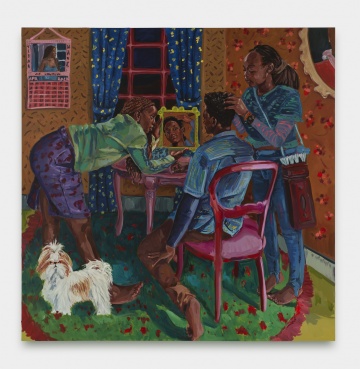
Wangari Mathenge
Tidal Wave of Colour
April 22, 2023 - June 3, 2023
Roberts Projects is pleased to present Tidal Wave of Colour, the newest body of work by artist Wangari Mathenge. This series, Mathenge’s first major solo show in the United States, is composed of eight paintings that range from the intimate to the immersive. The title takes its inspiration from civil rights icon Malcolm X, who used the phrase to capture the post-second World War zeitgeist of global revolution; between 1945 to 1955, ideas about liberation and independence permeated the world; and as a result, Africa, Asia, and Latin America revolted in pursuit of decolonization.
Kehinde Wiley
Colorful Realm
January 21, 2023 - April 8, 2023
Roberts Projects is delighted to announce Colorful Realm, an exhibition of new work from renowned contemporary artist Kehinde Wiley. Drawing inspiration from Japanese nature paintings of the Edo period (c.1600–1868), Wiley parallels traditional techniques and materials in nine monumental paintings. Exposed linen highlights the depicted natural scenes while also preserving the delicate balance of the untouched picture space . Per the artist, “So much of my work is about appearance and showing up and being visible, and this dance between exploring the vastness of space, and within the minimality of this technique I found to be an interesting juxtaposition.”
Lenz Geerk
June 11, 2022 - July 30, 2022
Lenz Geerk’s third solo show with the gallery is a deeply psychological exploration on the complexity of desire. Simmering tension permeates every work. Illicit relationships unfold on borrowed time against the sun-drenched light of summer. Geerk explores the shifts from attachment to separation, between closeness and distance, fusing perception and touch, by suggesting an edge that is loath to reveal itself completely. We wonder about, then question, what each relationship means.
Gwen Hollingsworth and Christine Turner
Frequency Illusion
June 11, 2022 - July 30, 2022
In Frequency Illusion, the unification of form and color within each artist’s practice reflects a surrounding world of inspiration.
Collins Obijiaku
Unexpected Sittings
April 30, 2022 - June 4, 2022
Marking Collins Obijiaku’s inaugural solo presentation with the gallery, the exhibition brings togethers fifteen new portraits made over the last year. Unexpected Sittings explores the potential behind every interaction, and how in these dynamic and, at times, complicated spaces one can become inspired to an unfamiliar degree.
Wish You Were Here: Part II
March 19, 2022 - April 16, 2022
A group show featuring Daniel Crews-Chubb, Alexandre Diop, Wangari Mathenge, Evan Nesbit, Otis Kwame Kye Quaicoe, Betye Saar, Ardeshir Tabrizi, Brenna Youngblood, and Taylor White.
Ed Templeton
The Spring Cycle
January 22, 2022 - March 5, 2022
Roberts Projects is pleased to announce The Spring Cycle, an exhibition of new paintings, drawings, and photographs by Ed Templeton that are a direct response to the suburban environment he lives in. These new works create hyperbolic realities that scrutinize the human condition through the lens of urban isolation. The exhibition runs January 22 - March 5, 2022. Due to the pandemic, an artist's reception will be held on Saturday, March 5th from 4–7pm. The Spring Cycle marks the artist's eighth solo show with the gallery.
Templeton’s most concise works to date continue earlier themes cynical of the provincial customs and rituals of his surroundings, notably the ever-polarizing political milieu over the last five years in Orange County where he lives and works. Suggestive imagery and unsettling portraits are joined with idyllic landscapes that verge on the pastoral to explore fragmented or at times distorted experiences with sensitivity and specificity. Details such as discarded religious pamphlets or signs, highlight how belief systems, however absurd, permeate our lives. The lack of specific environmental factors further highlights the enigmatic nature of each scene. Boundaries between what is public and private are blurred. Proxemics between people have no clear delineation, so relationships are not easily determined at first glance, if at all. The disdain is incandescent.
The linear compositions of the large-scale paintings epitomize the West Coast’s horizontal configurations, while smaller works evoke a more intimate quality. Templeton again employs a realistic style that has defined his painting practice; however, these new works see a lack of fantastical elements and the introduction of deep-set shadows, a divergence from his normally hyper-saturated palette. The realistic, straightforward suburban scenes are not unlike, in both sensibility and style, the mundane photographs of Ed Ruscha's book Twentysix Gasoline Stations (1963). Also on view are works on paper and the artist's original photographs, both of which provide considerable insight into the paintings.
Ruth Ige
Between Two Dimensions
January 22, 2022 - March 5, 2022
Between Two Dimensions is an ongoing exploration of both the material world and and the transcendental. A space where time is boundless, unrestrained, full of wonder. A place where liberation flies upon the wings of resistance. Cradled between the arms of all things hoped for and all things yet to be seen. A place of rest and comfort where Blackness is seen and heard and cherished. Where her laughter is not suppressed, and her pain is not discounted. In all her forms, wide and full to the brim, boundless. These new works by Ige draw inspiration from the expansive history of portrait painting, building up layers of paint until her subjects are are revealed within paint. Vortex’s within each painting interrupt the experience of each work by shredding the contours of the body and the face. Here, one finds their echo in the light.
Dominic Chambers, Wangari Mathenge, Alexandre Diop
Amendments
November 13, 2021 - January 8, 2022
This exhibition brings together an inspired selection of artworks focusing on artists deconstructing history, experience, and perspective, and the dialogue around painting and identity through contemporary portraiture. Dominic Chambers explores historical narratives around race and representation through works on paper, paintings, and writing. In deeply psychological paintings, Chambers builds a relationship between realism and imagery to center ideas of how and where to find joy. Wangari Mathenge’s highly stylized tableaux interrogates how self-identity is formed, expressed, and perceived across diverse cultural backgrounds. Often depicting people with whom she has significant relationships, she frequently paints small groups of individuals viewed from an interesting perspective, giving the feeling of insight into both subjects and circumstances. Alexander Diop’s large-scale portraits continue a journey exploring the transformative power of everyday objects while deconstructing structures of narrative and representation. Layering the canvas with paint, tar, straw, beads, fabric fragments and found objects, Diop creates an environment where both directed and intuitive interactions can occur. The work confronts and challenges and intervenes on how to modify oneself-or not-to take part of both culture and tradition.
Taylor White
November 13, 2021 - January 8, 2022
Large-scaled paintings are presented alongside more intimately scaled mixed-media work in Taylor White’s first exhibition with the gallery. Seen together, these works, and this exhibition, are as close to a perfect harmony as a dissonant melody can be. Large-scale paintings are presented alongside more intimately scaled mixed-media work. Dominating, colorful abstraction gives way to found and imagined landscapes as though seen through windows or down rifle scopes. Each painting has a tough balance within itself. Multilayered pieces contain sociological determinations between industrial and rural, memory and nostalgia, identity and community. Alienation from society, loss of identity, and the loss of self are buried in the deeper parts.
White’s landscapes are deeply complex. He simplifies complicated, expressionistic forms, reducing them to a compressed field of reference. Natural elements are almost eliminated, replaced instead by a rational approach to construction and proportions. Flat and lacking in perspective, his landscapes bridge purely abstract ideas with real spaces. In a striking motif, rifle-scope magnification lines demarcate off-center compositions, and create disturbing and intense conversations between subject, background, and surrounding negative space. There is a stylistic authenticity in his style reminiscent of Twombly’s graphic linework–specifically in the graffiti-like text across White’s paintings–and in emotional tension of Fontana’s rough-hewn, tangible materials.
The exhibition takes its title from Italo Calvino's novel Invisible Cities (1971), which explores the fictional dialogues between traveler Marco Polo and emperor Kublai Khan. The stories outlined by those involved are familiar; in his telling of the discovery and conquest of diverse cities, Calvino’s encapsulates the ubiquity of all cities, or, the every city. Evoking this familiarity, White’s newest work makes direct reference to the militarization of American historical memory, specifically in the discovery of “new” lands and the consequences of such exploration.
Nine paintings–loosely based off the chapter count of Invisible Cities–are arranged in a tight line, with the center painting positioned as the midpoint of the installation. Target Fixation, a phenomenon as common to photographers as it is to soldiers, focuses the eye on the middle. Materials including cardboard, metal rivets, and assembled sewn objects, lends a raw, utilitarian appearance to the surface of each work. Thick amounts of layered paint further accentuate this effect.
Amoako Boafo
SINGULAR DUALITY: ME CAN MAKE WE
September 18, 2021 - November 6, 2021
Roberts Projects is pleased to announce SINGULAR DUALITY: ME CAN MAKE WE, a solo exhibition by Amoako Boafo featuring new large-scale paintings that explore the tension of internal and external worlds, and of the complexities of shadow and light. Boafo’s second solo show with the gallery expands on his oeuvre representing and celebrating Blackness, while introducing significant new themes.
Situated at a pivotal juncture between the artist's celebrated mode of figuration and the development of a complex visual language, these magnificent new paintings introduce the subject's shadow. At once connected yet separated, Boafo’s characters are enigmatically coupled with their shadows.
In each of Boafo's newest paintings, light now casts a shadow, which becomes an image in its own right. Cantilevering outwards, shadows are rendered in muted but still luminous colors. As a result, Boafo’s paintings are now more archeological, more layered. Dark and light do not fuse into one another; rather, they oppose one another. The effect is not unlike Andy Warhol's Shadow series (1978-79), Goya's Black Paintings (ca. 1819-1823), or Francis Bacon’s Triptych, May–June 1973 (1973).
This duality, or “two-ness” (Du Bois 1705), informs Boafo’s approach to shape and space and structure taking hold in paint. The visual tension, specifically the shifts between positive and negative space, is a departure from how subjects were previously painted in even illumination.
All of the exhibited paintings continue to epitomize the bold yet simple colorful silhouettes typical of Boafo’s portraiture. His instantly recognizable strokes, imbued with rhythm and movement, accentuate the confidently applied hues of cerulean blue, yellow ochre, ripe reds and pinks. Loosely applied with his fingers, the paint used to depict skin tones of varying tonalities of black produces an illusion of three-dimensionality. Boafo also advances his earlier technique of using appliqué, transferring patterns from giftwrap papers to obtain rich textural effects to the paint surface. The emphasis is not merely to paint the figure, but to cultivate an atmosphere where, through texture and materials, reality is alchemized.
Boafo's limitless diversity – as it relates to both his characters and himself – continues to prompt discussion on the complexities of identity, community, and race. Depicting people both within and outside his intimate circle, Boafo's characters occupy the dominant space of each composition. Emotionally poignant, at times melancholic, expressions reveal the subject’s character and state of mind. Domestic settings and relaxed, natural poses grant further insight into Boafo's relationships with his characters. Artists, writers, models or friends, these are men and women he celebrates through his portraits.
Monstera Leaf Sleeves (2021) exemplifies Boafo’s exploration of the relationships between color and form, showing and hiding. Set against a dramatic yellow background, a young man in profile admires a clasped flower. He is isolated from the rest of the composition as the main focal point, joined only by the double-capture of his shadowed body. Stylish Overcoat (2021) shares the same characteristics. There is a conspicuous interaction of light and dark interplay between the main figure – a man stylishly outfitted in colorful clothing - and his shadow, which enveils him as would a halo.
In an essay recording his confrontation with the work of Francis Bacon, Gilles Deleuze articulates how "the shadow escapes from the body like an animal we had been sheltering" (Deleuze 1981). Within each of Boafo paintings, there is a process through which each of his characters can engender their own experience, whereas their shadow forces a negotiation between intention and the actual world. Jung believed the shadow cast by the unconscious mind contains the hidden aspects of the individual (Henderson 1964); Boafo contends that our shadow, or alternate reality, knows us better.
Boafo's painting is, at its core, a highly personal record of his and our existence during an extraordinary time. The desirous combination of the yearning and the deluge reflects on his and our moment: the coronavirus pandemic and its fallout; the impact of racial inequity; the effects of fame; balancing daily life; an uncertain, troubling future. He asks us how to discern between the two desires at odds in all people, and whether there is a possibility of redemption through growth?
In seeking to remake the world in his own image, Boafo navigates the shadow cast by his own path. His individual style remains influenced by movements that include The Vienna Secession, though it is his contemporary sensibility that ensures his work looks to the future rather than to its past. Rather than simply painting what is there – witness earlier work – Boafo's pursual of the psychological depth of pictoral representation (Gombrich 1956) moves his ideas onwards.
In this evolution, Boafo’s works find new meaning. With this show Amoako Boafo expands from superb Black representation to portraits that chart and encompass the totality of the human experience.
Betye Saar
Black Doll Blues
September 18, 2021 - November 6, 2021
“Betye Saar: Black Doll Blues” brings together a selection of new watercolor works on paper, portraits of Saar’s personal collection of Black dolls. Referencing the underrepresented history of Black dolls as seen through Saar’s artistic lens, the works on view distill several intersecting themes, imagery, and objects in Saar’s oeuvre, highlighting her prominent usage and reinvention of derogatory imagery.
From 1880s European brown bisque dolls to dolls hand-made with found materials by enslaved people up to more recent examples such as Mattel’s 1968 first Black Barbie (Christie) or Addie of the American Girl Dolls, Black dolls often embodied the experiences and narratives of those who made them and/or received them. The Black dolls represent and reflect part of historical Black American culture.
Characterizing Saar's unique practice, these watercolors showcase the artist’s experimentation with vivid colors, layered techniques, and new interest in flat shapes. While Saar has previously used painting in her mixed media collages, this is her first exhibition focusing on her watercolor works on paper. The exception in this exhibition is Rock-a-bye Black Babies, a tableau that features a child’s rocker holding dolls from Saar’s personal collection.
Daniel Crews-Chubb
Solitary Us: Couples Paintings
July 8, 2021 - August 14, 2021
The Couples paintings are a new series produced during the lockdown period in the UK due to the COVID-19 pandemic. They explore relationships and human interactions, and are self-reflective and reactionary to the sense of isolation and solitude the artist was feeling at the time.
This follows “Chariots, Beasts, and Belfies,” the gallery’s inaugural presentation with the artist in 2018.
Otis Kwame Kye Quaicoe
ONE BUT TWO (Haadzii)
June 5, 2021 - July 3, 2021
ONE BUT TWO (Haadzii) highlights new paintings continuing Quaicoe’s idiosyncratic perspective on Diasporic culture through the celebrated form of Black portraiture. The son of a twin, Quaicoe explores these complex relationships through dualistic representation and double portraiture in vivid large-scale paintings. This exhibition follows "Black Like Me," the gallery’s inaugural presentation with the artist and his first solo gallery exhibition in the United States, which took place January 2020.
Brenna Youngblood
Brenna Youngblood: the LIGHT and the DARK
March 20, 2021 - May 15, 2021
the LIGHT and the DARK, Brenna Youngblood’s inaugural exhibition at the gallery, takes as its genesis the artist's experience navigating the difficulties of last year and applying her lived experiences – endured as two separate but simultaneous realities – to her practice. From a deadly pandemic to a global movement for equitable racial justice, 2020 was defined by its world-shifting events.
The works on view hold space for light and dark, and the material representation of both by taking into account their own considerations and possibly different ideas surrounding each, but as a whole the show is committed to Youngblood’s highly personal response to her particular memories and experiences addressing the events and issues we have seen unfold so far. the LIGHT and the DARK brings together twelve energy-filled mixed-media collages on canvas and board.
Jeffrey Gibson
Jeffrey Gibson: It Can Be Said of Them
January 9, 2021 - February 27, 2021
Jeffrey Gibson’s exhibition will feature new work exploring themes of identity, as it relates to diversity and inclusivity, to uplift unique experiences, struggles and personal victories shaping the fight for LGBTQIA visibility. Taking its title from a print produced by Sister Corita Kent in 1969 of the same name, It Can Be Said of Them will be Gibson’s second show with the gallery.
Rachel Rosenthal
Rachel Rosenthal: Thanks Collage Works from the 1970's
October 24, 2020 - December 12, 2020
Roberts Projects is delighted to announce Thanks: Collage Works from the 1970’s, an exhibition of works on paper by Rachel Rosenthal (1926-2015). Organized in collaboration with the Rachel Rosenthal Estate, the exhibition features never before exhibited collage works from the 1970's documenting Rosenthal’s autobiographical reflection of a pivotal time in her early artistic development. The show takes its title after the artist’s second performance at Wilshire Plaza West, Westwood, California (1975), in which she thanked those who had actively done something important for her, with the audience participating in the familiar roles of “father,” “mother” and “friend.” The performance marked the year of her mother’s death, twenty years after her father’s. At the end of performance, each of the participants received a small box containing a unique miniature collage work from the artist.
Amoako Boafo, Daniel Crews-Chubb, Lenz Geerk, Jeffrey Gibson, Wangari Mathenge, Otis Kwame Kye Quaicoe, Betye Saar, Kehinde Wiley, Ardeshir Tabrizi
Synchronicity
September 19, 2020 - December 5, 2020
The Dalai Lama once said, “I am open to the guidance of synchronicity and I do not let expectations hinder my path,” meaning he allows himself the intervention of the unknown rather than being tied to any predetermined notions of what could or should be. Synchronicity, as it relates to the creation of art, follows the same principles in that all great art allows for the possibility of improvisation, chance or the “divine accident,” wherein the artist discovers inspiration in a place they might never have thought to look initially. In any circumstance, the improbable always yields more gold than the obvious.
But how do artists recognize not only the importance of improbability, but foster this kind of high level receptivity? How do you find something by deliberately not seeking it out, knowing that in this ineffable gesture is the most powerful kind of artistic expression? It requires an understanding of the laws that govern the universe, or as Einstein once said, “the secret to creativity is knowing how to hide your sources, even from yourself,” that is, to have faith that what we are seeking in the living world is also seeking us; to receive everything, all we need do is to be open to it.
This exhibition takes as its subject the nebulous, syncretic moment, celebrates the ambiguous gesture and expounds on the improbable instance where magical thinking occurs without our knowledge or awareness. For example, the paintings of Lenz Geerk investigate the strange and luminous distance between figures and objects, creating a force-field of psychologically charged spaces. Brenna Youngblood explores the boundaries between language and abstraction, investigating the nuances and complexities of words and how meanings can be subverted and reinterpreted, whereas Kehinde Wiley employs a more traditional painterly approach, using the visual language of old master portraiture to subvert myth and symbol alike. Beyte Saar’s sculptural investigations continue to compel and surprise while raising important questions about identity, as do Jeffrey Gibson’s contemporary sculptural figures.
All the artists in this exhibition are not only imaginative and curious about the world around them, but also bring to their work a level of inquisitiveness that supersedes cognition - instead, privileging instinct - and both a playfulness and a willingness to commit to the improbable and the ambiguous to allow life’s riddles to remain unsolved.
To continue the works’ challenge of conventional categories and their relationship to one another, this exhibition will open in phases, with individual pieces introduced throughout the duration of the exhibition.

 Back to all Member Galleries
Back to all Member Galleries
